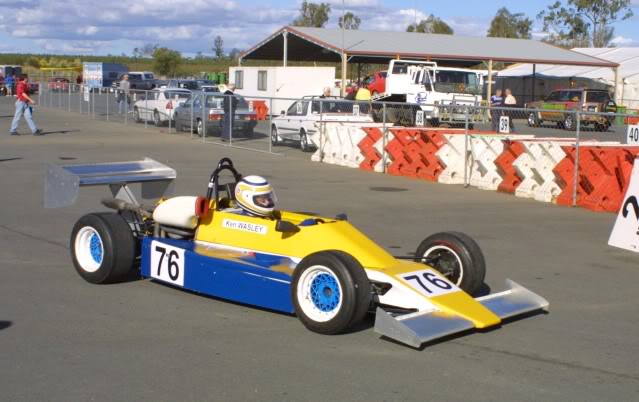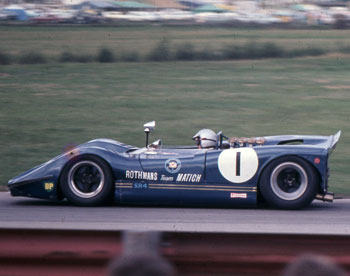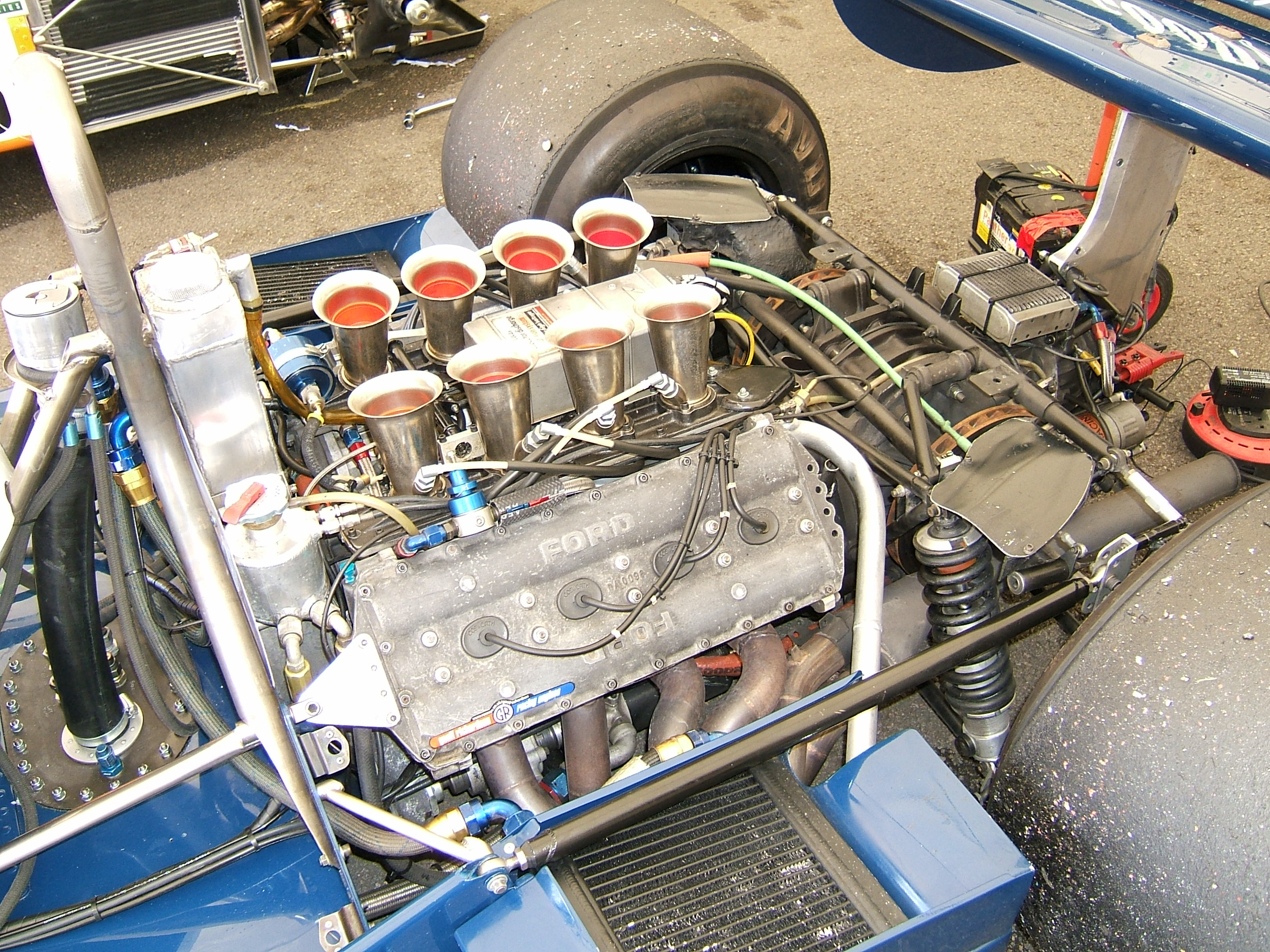|
Kaditcha
Kaditcha was an automobile manufacturer in Australia. The company, formed by Queensland engineer Barry Lock, made open wheel and sports car racing cars, including cars for Formula 5000, Formula Pacific and Australian Formula 2. Sports cars The peak of Kaditcha's form was in the mid-1980s when Kaditcha sports cars dominated the Australian Sports Car Championship. Chris Clearihan won the 1982 Championship in a 5.0L Chevrolet powered version, with Kaditcha's finishing that year in 1st, 2nd and 3rd places. Clearihan finished 3rd in the 1983 Championship, which was won by Peter Hopwood driving a later model Kaditcha-Chevrolet that Lock built using a Lola T400 Formula 5000 as its base. Hopwood moved to the Australian Drivers' Championship in 1984 with Clearihan taking over the 1983 title winning car and finished second in the 1984 Championship. Kadticha's most famous race car is one that no longer bears its name. The Romano WE84 raced by Bap Romano began its racing life in 1983 as th ... [...More Info...] [...Related Items...] OR: [Wikipedia] [Google] [Baidu] |
1983 Australian Sports Car Championship
The 1983 Australian Sports Car Championship was a CAMS sanctioned motor racing title for drivers of Group A Sports Cars.CAMS Manual of Motor Sport, 1983, pages 91-94 It was the fifteenth Australian Sports Car Championship. Peter Hopwood, driving the Steve Webb owned Kaditcha Chevrolet, won the championship from Ray Hanger in a Rennmax Ford. Defending champion Chris Clearihan finished third in his older model Kaditcha Chevrolet. The 1983 championship saw the debut of the Bap Romano owned and driven Kaditcha K583 Cosworth, the first Australian Group A Sports Car built with a closed top and Ground effects aerodynamics (Clearihan's Kaditcha also appeared with a bolted on closed top in the early rounds of the season but the top was later removed). The K583 would prove to be the fastest car in the field in 1983, and would compete in Class B as the ex-McLaren Cosworth DFV V8 was a 3.0 litre engine. However, unreliability and a disqualification for dangerous driving in Round 4 at Lake ... [...More Info...] [...Related Items...] OR: [Wikipedia] [Google] [Baidu] |
Romano WE84
The Romano WE84 is an Australia, Australian designed and built, mid-engined closed top racing car built to Confederation of Australian Motorsport, CAMS Group A Sports Cars, Group A Sports Car specifications. The car began its life as the Kaditcha, Kaditcha K583 when it first appeared in the 1983 Australian Sports Car Championship and was built by the Queensland based Kaditcha owner and former McLaren engineer Barry Lock after he was approached by Brisbane accountant, property developer, timber mill owner and former Dirt track racing, speedway racer Bap Romano in 1981 with the idea of building a 24 Hours of Le Mans, Le Mans type coupe. When the car first appeared in 1983, it was the first closed top Sports Car seen in Australia and looked like an FIA Group C Sports Car (such as the Porsche 956) rather than the open cockpit Can-Am style cars of previous years. This led to the false belief that it was built to the Group C regulations Bap Romano's ultimate ambition was to take the car ... [...More Info...] [...Related Items...] OR: [Wikipedia] [Google] [Baidu] |
1984 Australian Sports Car Championship
The 1984 Australian Sports Car Championship was an Australian motor racing title open to Sports Cars complying with CAMS Group A regulations.Conditions for Australian Titles, CAMS Manual of Motor Sport, 1984, pages 88-91 It was the 16th Australian Sports Car Championship. Queensland based owner/driver Bap Romano won the championship driving his Romano WE84 Cosworth. 1982 champion Chris Clearihan, (driving the Kaditcha-Chevrolet that Peter Hopwood used to win the 1983 Championship), placed second and Andrew Roberts, driving a self designed Roberts S2 Ford, placed third. Romano dominated the championship, continuing on from his victory in the final round of the 1983 Championship at Winton. With engineering help from former Williams and Tyrrell Formula One mechanic Wayne Eckersley transforming the Barry Lock built car, Romano put the renamed Romano WE84 (formerly called a Kaditcha K583) on pole position at every round and scored fastest lap in each race which he contested. He ... [...More Info...] [...Related Items...] OR: [Wikipedia] [Google] [Baidu] |
1982 Australian Sports Car Championship
The 1982 Australian Sports Car Championship was a CAMS sanctioned Australian motor racing title open to Group A Sports Cars.Australian Title Conditions, 1982 CAMS Manual of Motor Sport, pages 87-93 It was the fourteenth Australian Sports Car Championship,Records, Titles and Awards, 2002 CAMS Manual of Motor Sport, page 14-6 and the first to be contested by Group A cars since 1975.Australian Sports Car Championship, Australian Motor Racing Yearbook 1982/83, pages 188-197 The championship was won by Chris Clearihan of Canberra, driving a Kaditcha Kaditcha was an automobile manufacturer in Australia. The company, formed by Queensland engineer Barry Lock, made open wheel and sports car racing cars, including cars for Formula 5000, Formula Pacific and Australian Formula 2. Sports cars The pe .... Schedule The championship was contested over a four-round series. Class structure Cars competed in two classes: * Under 2.5 litres * Over 2.5 litres Points system Championship points ... [...More Info...] [...Related Items...] OR: [Wikipedia] [Google] [Baidu] |
Australian Sports Car Championship
The Australian Sports Car Championship was the national title for sports car racing drivers sanctioned by the Confederation of Australian Motor Sport from 1969 to 1988. Each championship was contested over a series of races with the exception of the 1975 title, which was awarded on the results of a single race held at the Phillip Island circuit in Victoria. Championship races were open to purpose-built sports racing cars complying with CAMS Group A Sports Car regulations except for the years 1976 to 1981 in which they were restricted to Group D Production Sports Cars. Local manufacturers Matich, Elfin, Kaditcha, and K&A Engineering ( Veskanda C1), along with McLaren dominated the series when run under Group A rules, while Porsche drivers won all six Group D based championships. The championship winners are listed below. {, class="wikitable" style="font-size: 95%;" ! Year ! Champion ! Vehicle , - ! 1969 , Frank Matich , Matich SR4 Repco , - ! 1970 , Peter Woodward , ... [...More Info...] [...Related Items...] OR: [Wikipedia] [Google] [Baidu] |
Group A Sports Car
Group A Sports Cars is an Australian motor racing category that CAMS formulated for sports car racing in Australia. Introduced in 1964, it continues today under the name Group 2A Sports Cars. On introduction in 1964, Group A catered only for closed sports racing cars with their open top counterparts continuing under existing CAMS Appendix C Sports Car regulations. For 1965, the Appendix C Sports Cars category was discontinued with Group A now catering for both open and closed sports cars. Vehicles were required to have two seats, two doors, mudguards, and an electrical system with operable lights, horn, and starter. Although the rules required that cars also be capable of being registered for road use, the category was not intended for production based cars, which were accommodated by two other newly introduced CAMS categories, Group B Improved Production Sports Cars and Group D Series Production Sports Cars. Initially, mechanical elements under Group A were virtually unrestricte ... [...More Info...] [...Related Items...] OR: [Wikipedia] [Google] [Baidu] |
Australian Formula 2
Australian Formula 2, sometimes abbreviated to AF2 or ANF2, is a "wings and slicks" formula racing category in Australia. The category is one of Australia's oldest, dating back to 1964. The current format of AF2 was introduced in 1978. Brian Shead of Cheetah Racing Cars and Garrie Cooper of Elfin Racing Cars were largely responsible for the development of the format, which was devised to suit the needs of Australian drivers, most of whom had little or no sponsorship and had to bear the costs of racing out of their own pockets. The class was an amalgamation of the previous Australian Formula 2 and Australian Formula 3 categories, using the same or newly developed cars, but powered by production-based single-cam, 2 valve per cylinder engines, with an engine capacity between 1100 cc and 1600 cc. Popular engines initially included the Toyota 2T, Ford Kent and Holden Gemini. Later on the Volkswagen Golf became the engine of choice due to its lighter weight and greater power levels. In ... [...More Info...] [...Related Items...] OR: [Wikipedia] [Google] [Baidu] |
Calder Park Raceway
Calder Park Raceway is a motor racing circuit in Melbourne, Victoria, Australia. The complex includes a dragstrip, a road circuit with several possible configurations, and the "Thunderdome", a high-speed banked oval equipped to race either clockwise (for right-hand-drive cars) or anti-clockwise (for left-hand-drive cars such as NASCAR). History Calder Park Raceway was founded in the farming community of Diggers Rest and began as a dirt track carved into a paddock by a group of motoring enthusiasts who wanted somewhere to race their FJ Holdens. One of those men was Patrick Hawthorn, who at the time owned a petrol station in Clayton, when one of his clients suggested a place to race, on his property. The inaugural meeting on a bitumen track was run by the Australian Motor Sports Club and took place on 14 January 1962. The track design was very similar to the existing Club Circuit, which is still in use today. Competitors at this meeting included former Calder Park owner Bob Jan ... [...More Info...] [...Related Items...] OR: [Wikipedia] [Google] [Baidu] |
Cosworth DFV
The DFV is an internal combustion engine that was originally produced by Cosworth for Formula One motor racing. The name is an abbreviation of ''Double Four Valve'', the engine being a V8 development of the earlier four-cylinder FVA, which had four valves per cylinder. Its development in 1967 for Colin Chapman's Team Lotus was sponsored and funded by major American automotive manufacturer Ford Motor Company, Ford. For many years it was the dominant engine in Formula One, with the whole engine program funded by Ford's European division, Ford Europe and engines badged as "Ford" for Formula One championship races. DFVs were widely available from the late 1960s to the mid 1980s and were used by every specialist team in F1 during this period with the exception of Ferrari, Alfa Romeo, Renault, BRM and Matra, who all designed, produced and ran their own engines. Variants of this engine were also used in other categories of racing, including Champ Car, CART, Formula 3000 and sports car ra ... [...More Info...] [...Related Items...] OR: [Wikipedia] [Google] [Baidu] |
Cosworth DFL
The DFV is an internal combustion engine that was originally produced by Cosworth for Formula One motor racing. The name is an abbreviation of ''Double Four Valve'', the engine being a V8 development of the earlier four-cylinder FVA, which had four valves per cylinder. Its development in 1967 for Colin Chapman's Team Lotus was sponsored and funded by major American automotive manufacturer Ford. For many years it was the dominant engine in Formula One, with the whole engine program funded by Ford's European division, Ford Europe and engines badged as "Ford" for Formula One championship races. DFVs were widely available from the late 1960s to the mid 1980s and were used by every specialist team in F1 during this period with the exception of Ferrari, Alfa Romeo, Renault, BRM and Matra, who all designed, produced and ran their own engines. Variants of this engine were also used in other categories of racing, including CART, Formula 3000 and sports car racing. The engine is a 90°, 2 ... [...More Info...] [...Related Items...] OR: [Wikipedia] [Google] [Baidu] |
Mazda Wankel Engine
The Mazda Wankel engines are a family of Wankel rotary combustion car engines produced by Mazda. Wankel engines were invented in the early 1950s by Felix Wankel, a German engineer. Over the years, displacement has been increased and turbocharging has been added. Mazda rotary engines have a reputation for being relatively small and powerful at the expense of poor fuel efficiency. The engines became popular with kit car builders, hot rodders and in light aircraft because of their light weight, compact size, tuning potential and inherently high power-to-weight ratio—as is true for all Wankel-type engines. Mazda put the engine into series production with NSU ( Ro80) and Citroën ( GS Birotor) as part of the Comotor joint-venture between 1967 and 1977. Since the end of production of the Mazda RX-8 in 2012, the engine was produced only for single seater racing, with the one-make Star Mazda Championship being contested with a Wankel engine until 2017; the series' transition to usi ... [...More Info...] [...Related Items...] OR: [Wikipedia] [Google] [Baidu] |
V8 Engine
A V8 engine is an eight-cylinder piston engine in which two banks of four cylinders share a common crankshaft and are arranged in a V configuration. The first V8 engine was produced by the French Antoinette company in 1904, developed and used in cars and speedboats but primarily aircraft; while the American 1914–1935 ''Cadillac L-Head'' engine is considered the first road going V8 engine to be mass produced in significant quantities. The popularity of V8 engines in cars was greatly increased following the 1932 introduction of the ''Ford Flathead V8''. In the early 21st century, use of V8 engines in passenger vehicles declined as automobile manufacturers opted for more fuel efficient, lower capacity engines, or hybrid and electric drivetrains. Design V-angle The majority of V8 engines use a V-angle (the angle between the two banks of cylinders) of 90 degrees. This angle results in good engine balance, which results in low vibrations; however, the downside is a larg ... [...More Info...] [...Related Items...] OR: [Wikipedia] [Google] [Baidu] |







